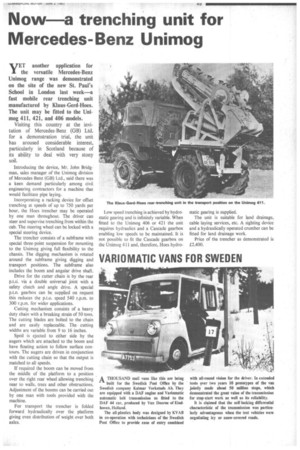Now—a trenching unit for Mercedes-Benz Unimog
Page 51

If you've noticed an error in this article please click here to report it so we can fix it.
YET another application for the versatile Mercedes-Benz Unimog range was demonstrated on the site of the new St. Paul's School in London last week—a fast mobile rear trenching unit manufactured by Klaus-Gerd-Hoes. The unit may be fitted to the Unimog 411, 421, and 406 models.
Visiting this country at the invitation of Mercedes-Benz (GB) Ltd. for a demonstration trial, the unit has aroused considerable interest, particularly in Scotland because of its ability to deal with very stony soil.
Introducing the device, Mr. John Bridgman, sales manager of the Unimog division of Mercedes-Benz (GB) Ltd., said there was a keen demand particularly among civil engineering contractors for a machine that would facilitate pipe laying.
Incorporating a racking device for offset trenching at speeds of up to 750 yards per hour, the Hoes trencher may be operated by one man throughout. The driver can steer and supervise trenching from within the cab. The steering wheel can be locked with a special steering device.
The trencher consists of a subframe with special three-point suspension for mounting to the Unimog giving full flexibility to the chassis. The digging mechanism is rotated around the subframe giving digging and transport positions. The subframe also includes the boom and angular drive shaft.
Drive for the cutter chain is by the rear p.t.O. via a double universal joint with a safety clutch and angle drive. A special p.t.o. gearbox can be supplied on request this reduces the p.t.o. speed 540 r.p.m. to 300 r.p.m. for wider applications.
Cutting mechanism consists of a heavy duty chain with a breaking strain of 50 tons. The cutting blades are bolted to the chain and are easily replaceable. The. cutting widths are variable from 9 to 16 inches.
Spoil is ejected to either side by the augers which are attached to the boom and have floating action to follow surface contours. The augers are driven in conjunction with the cutting chain so that the output is matched to all speeds.
If required the boom can be moved from the middle of the platform to a position over the right rear wheel allowing trenching near to walls, trees and other obstructions. Adjustment of the booms can be carried out by one man with tools provided with the machine.
For transport the trencher is folded forward hydraulically over the platform giving even distribution of weight over both axles. Low speed trenching is achieved by hydrostatic gearing and is infinitely variable. When fitted to the Unimog 406 or 421 the unit requires hydraulics and a Cascade gearbox enabling low speeds to be maintained. It is not possible to fit the Cascade gearbox on the Unimog 411 and, therefore, Hoes hydro static gearing is supplied.
The unit is suitable for land drainage, cable laying services, etc. A sighting device and a hydraulically operated crumber can be fitted for land drainage work.
Price of the trencher as demonstrated is £2,400.




























































































































































